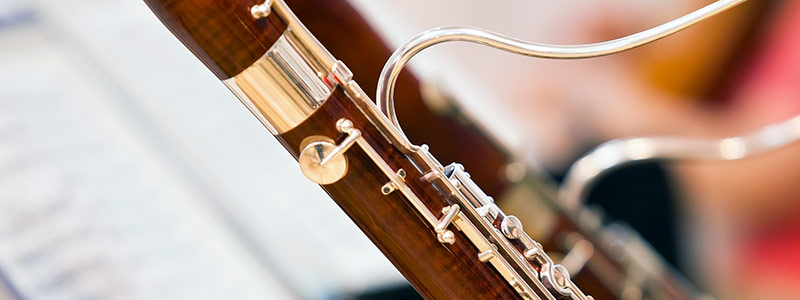
What is a bassoon? What’s the difference between the clarinet and oboe? As a bassoonist myself, I get asked these types of questions all too often. There’s no hard feelings though; they are uncommon, funny-sounding, and odd looking instruments indeed! With that said, allow me to shed some light on the matter!
The bassoon and oboe are woodwind instruments in the double-reed family. A double-reed, unlike a saxophone or clarinet reed, is two pieces of cane wound together by string, not a single piece of cane fastened to a mouthpiece by a ligature. Double-reeds require the use of a complex embouchure, so they aren’t typically instruments students start out on in elementary band, but will later switch to in high school, usually making the crossover from clarinet, saxophone, or flute.
The oboe is a C instrument that plays in the treble clef, and is known as a beautiful solo instrument in orchestral settings. The oboe’s close relative, the English Horn, has a warmer, deeper sound, and is almost exclusive to players in collegiate and professional orchestras.
The bassoon is a C instrument that plays in the bass clef. In middle and high school band, the bassoon will typically play similar parts to the trombone and tuba, also bass clef brass instruments. In more advanced orchestral music, it is known as a warm, dark solo instrument. The contrabassoon, a cousin to the bassoon, plays an entire octave lower than the standard bassoon, and like the English Horn, are generally only seen in professional orchestras.
If you are a student making the crossover from a wind instrument to either the oboe or the bassoon, choosing a reed can seem a little daunting, especially after hearing how different they are from clarinet and sax reeds. Luckily, there are a few tips that I personally recommend to beginners when asked about reed strengths and the best fit. Unlike most clarinet and saxophone reeds, bassoon and oboe reeds do not come in number strengths, like 2, 2.5, and 3. Instead, double-reeds typically come in the strengths of soft, medium-soft, medium, medium-hard, and hard. The softer the reed, the easier it will be on the player’s embouchure and to produce sound. If you are switching over from a brass instrument, like I did in 8th grade from the trombone, I would start on a soft or medium-soft reed, as your embouchure has some strength, but will still need to adjust to the complex reed. If you are switching from a woodwind instrument after some years of playing, starting on a medium-soft or medium reed will be a good fit, depending on what you as the player prefers sound and comfort-wise. Medium-hard and hard reeds are what experienced double-reed players use, as the harder cane is for a strong and conditioned embouchure.
When it comes to reeds, I myself use Jones, as they are not factory cut on an assembly line, but hand cut. For oboe, “Singin’ Dog!” or Jones are a great choice, as both are also hand cut.
The bassoon and oboe are both beautiful double-reed instruments, and although they can be somewhat difficult to grasp when initially making the crossover from single-reed territory, they are incredibly rewarding instruments to any player who decides to take the challenge.
